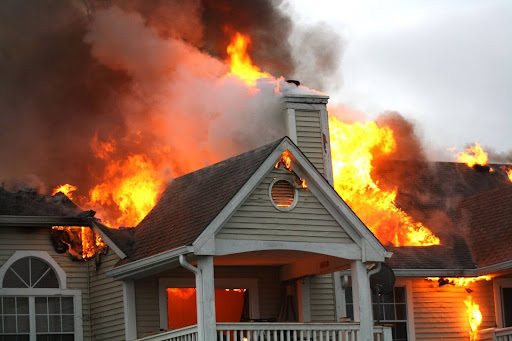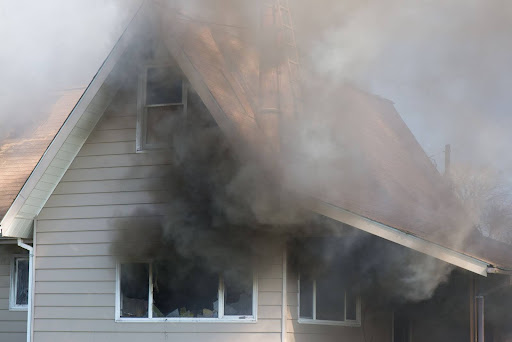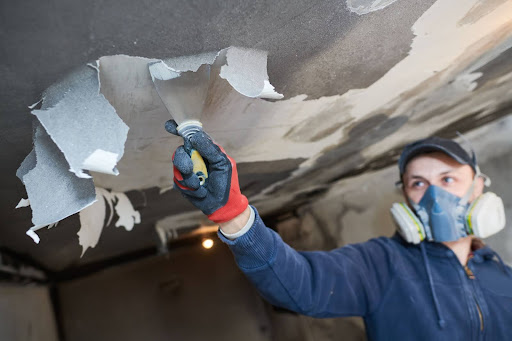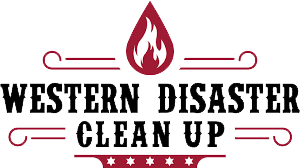The distinction between smoke damage and fire damage is an essential topic that affects countless homeowners and property owners. Why is this difference crucial? Because understanding it significantly impacts how you respond to and deal with the aftermath of a fire-related incident.
Fires are devastating events, leaving behind a trail of destruction and upheaval. Yet, the damage caused by a fire isn’t limited to just what the flames consumed. Smoke often doesn’t get the attention it deserves, but it plays a pivotal role in the havoc wreaked upon structures and possessions during a fire.
By grasping the finer points of smoke and fire damage, you can make well-informed choices when facing such unfortunate circumstances.
In the sections ahead, we’ll explain the definitions, distinctions, and implications for recovery and restoration efforts. Whether you’re a homeowner, property manager, or simply someone with an interest in fire safety, this knowledge is invaluable for safeguarding your investments and ensuring the welfare of your loved ones.

What is Fire Damage?
Fire damage refers to the destruction inflicted by flames during a fire-related incident, including the harm caused to structures, personal belongings, and the immediate surroundings due to the intense heat and flames generated during a fire.
The temperatures reached during a fire can exceed 1,000 degrees Celsius (1,800 degrees Fahrenheit), leading to structural damage such as weakened foundations, compromised walls, and collapsed roofs. Within homes and businesses, fire damage can destroy furniture, electronics, clothing, and other personal items.
Signs and Effects of Fire Damage
Identifying fire damage is crucial for effective recovery efforts. Common signs include charred or blackened surfaces, warped materials, and the presence of soot and smoke residues. Additionally, fire damage often leaves behind the acrid odor of smoke, which can persist for an extended period.
The effects of fire damage go beyond the visible. It weakens the structural integrity of buildings, posing safety risks. Furthermore, the toxic gases released during a fire contaminate the air and pose health hazards. Prompt and thorough addressing of fire damage is essential to mitigate its detrimental effects.
By gaining a profound understanding of fire damage, you’ll be better equipped to navigate the recovery process and ensure the comprehensive restoration of your property. In the following section, we’ll explore its counterpart, smoke damage, shedding light on its distinct characteristics and implications.

What is Smoke Damage?
Smoke damage encompasses the wide range of harmful effects resulting from the interaction between smoke particles and various surfaces and materials within a structure. Smoke damage is just as destructive as fire damage, albeit in different ways.
Smoke comes in various types, each with distinct characteristics:
Wet Smoke: This type of smoke is a result of slow-burning, low-heat fires. It has a sticky, smeary texture and can be challenging to clean. Wet smoke often leaves behind a strong, pungent odor.
Dry Smoke: Dry smoke is a result of high-heat, fast-burning fires. It has a powdery, dry texture and tends to affect a wider area. While it can be less challenging to clean than wet smoke, it still poses significant restoration challenges.
Protein Smoke: The burning of organic materials, such as food or grease, produces protein smoke. It often leaves behind a nearly invisible residue that can be easily overlooked. However, it has a strong and persistent odor.
Petroleum Smoke: This type of smoke is generated by the burning of oil-based substances, like plastics or synthetics. It is thick and black and is known for its toxic nature.
Smoke has a knack for infiltrating even the most concealed spaces within a structure. It penetrates porous surfaces, such as walls, ceilings, and fabrics, leaving behind soot and residues. Smoke damage also affects non-porous surfaces like glass and metal, causing discoloration and corrosion.
Smoke’s odor is pervasive, permeating not only visible areas but also lingering within the building’s ventilation system. Smoke damage can lead to long-term health issues if not adequately addressed.
Understanding the diverse nature of smoke damage and its impact on different materials and surfaces is essential for devising an effective restoration plan.
Key Differences Between Smoke and Fire Damage
Now that we’ve delved into the intricacies of fire and smoke damage individually let’s draw a clear distinction between the two and understand why recognizing these differences is pivotal for effective restoration.
Nature of Damage: Fire damage primarily results from the flames themselves, encompassing structural destruction, charring, and direct heat-related harm to materials. On the other hand, smoke damage encompasses the various effects caused by smoke particles interacting with surfaces, including soot, residues, and odor.
Visibility: Fire damage is usually more visible since it leaves behind obvious signs like charred walls, ceilings, and objects. In contrast, smoke damage might not always be immediately visible, with residues and odors often lurking beneath the surface.
Types of Damage: While fire damage might be more localized, directly affecting areas touched by flames, smoke damage spreads further and affects a broader range of surfaces, both near and distant from the fire’s origin.
Restoration Challenges: Fire damage typically requires structural repairs and reconstruction. Smoke damage, on the other hand, demands thorough cleaning, deodorization, and the removal of soot and residues from various surfaces.
Recognizing the disparities between fire and smoke damage empowers restoration teams to implement tailored solutions, ensuring a more efficient and effective recovery process. By being aware of these distinctions, you’re better equipped to navigate the restoration journey after a fire incident.
Significance of Professional Restoration Services
When faced with the aftermath of a fire incident, enlisting the expertise of professional restoration services is paramount.
Expertise and Experience: Restoration professionals possess the knowledge and experience required to assess the extent of damage accurately. They understand the distinct characteristics of fire and smoke damage and can formulate a tailored plan for restoration.
Efficient Cleanup: Professionals use specialized equipment and techniques to efficiently clean and deodorize affected areas. Their expertise ensures that no detail is overlooked, from structural repairs for fire damage to thorough cleaning for smoke residues.
Odor Removal: Smoke odors can be persistent and challenging to eliminate. Restoration experts have access to advanced deodorization methods and equipment, ensuring that your space smells fresh once again.
The restoration process involves several crucial steps for addressing both smoke and fire damage:
- Assessment: Restoration professionals start by conducting a comprehensive assessment of the damage. This includes identifying areas affected by fire, soot, smoke residues, and odor.
- Safety measures: Ensuring safety is paramount. Restoration teams assess structural integrity and any potential hazards before proceeding.
- Structural repairs: In cases of fire damage, structural repairs take priority. These repairs may involve rebuilding damaged walls, ceilings, and other structural components.
- Cleaning: Thorough cleaning is essential to remove soot, residues, and smoke particles from surfaces. Restoration experts use specialized cleaning agents and techniques tailored to the type of damage.
- Deodorization: Addressing smoke odors requires targeted deodorization methods. Professionals employ ozone generators, thermal fogging, or other odor-neutralizing techniques.
- Restoration: The final step involves restoring your space to its pre-damage condition. Restoration efforts may include repainting, replacing flooring, and ensuring that every aspect of your property looks and functions as it should.
Addressing fire and smoke damage requires a swift response to reap various benefits. First and foremost, acting promptly can prevent further damage, such as the onset of mold growth, which may occur if moisture and soot residues are left unattended.
Additionally, a quick response contributes to cost efficiency by minimizing overall repair expenses. Delays in addressing the damage may lead to more extensive harm, resulting in increased costs.
Facilitating a speedier return to normalcy helps reduce the emotional toll of the incident on those affected.
Preventing Smoke and Fire Damage
While understanding the differences between smoke and fire damage is crucial, taking proactive steps to prevent these incidents is equally important.
Here are some practical measures and safety tips to help you reduce the risk of smoke and fire damage.
First and foremost, installing smoke alarms serves as your initial defense. Having operational smoke detectors on every level of your residence and inside each bedroom is essential. Regularly testing them and replacing batteries as needed ensures their effectiveness.
Another crucial safety measure involves fire extinguishers. Keep them in easily accessible locations, such as the kitchen and garage. Familiarize yourself with their usage and ensure they are in good working condition.
Kitchen safety is paramount since it’s a common area for fires. Never leave cooking unattended, and maintain a safe distance between flammable materials and stovetops. It’s advisable to keep a lid nearby to smother grease fires if they occur.
Electrical safety plays a significant role in fire prevention. Overloaded electrical outlets and faulty wiring are fire risks. Regular inspections of your electrical system and avoiding overloading outlets with too many devices are essential precautions.
Additionally, heating equipment maintenance is crucial. This applies to furnaces, fireplaces, and space heaters. Proper ventilation and the removal of flammable items from heat sources are vital steps to take.
When it comes to open flames, exercising caution is essential. If you use candles, never leave them unattended. Consider flameless candles as a safer alternative.
Lastly, for those who smoke, it’s advisable to do so outdoors and utilize proper receptacles for cigarette butts. Smoking indoors significantly increases the risk of accidental fires.

Smoke & Fire Damage Restoration with Western Disaster Clean Up
Western Disaster Clean Up is your trusted ally in navigating the challenges of fire and smoke damage. Our experienced team, state-of-the-art equipment, and commitment to swift, efficient restoration make them the go-to choice for recovery and peace of mind.
So, if you find yourself in need of smoke or fire damage restoration, contact Western Disaster at 385-381-6539.

